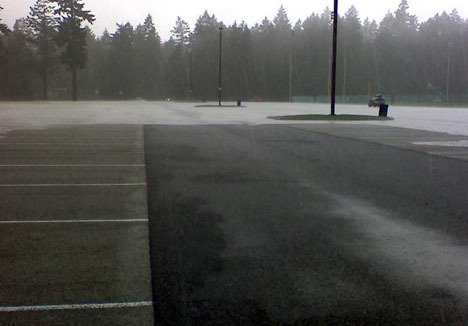During a heavy rainstorm not long ago, a woman sitting in her car at the Sprinker Recreation Center parking lot in Spanaway happened to notice that the entire pavement was flooded with rain water except for one area. It was so amazing that she grabbed her camera and took a few photos.
What she observed was a Pierce County Public Works and Utilities pilot project in action. The project tested porous asphalt and concrete as part of a strategy to improve local water quality and drainage.
Porous asphalt and concrete and other features such as vegetated infiltration facilities are examples of earth-friendly construction techniques known collectively as low impact development, or LID.
Sprinker’s 7.6-acre parking lot was constructed in 1969 and all runoff was collected in catch basins and piped directly into Spanaway Creek. Storm runoff from paved areas can pick up oil and other pollutants which, unless treated, go directly into local streams. Paved areas also allow storm water to enter streams very quickly, contributing to winter time flooding and other issues.
The pilot project, located in the southwest portion of the parking lot, was installed a year ago to determine whether selected LID techniques could provide effective water quality treatment at this location, and whether the entire parking lot could be later retrofitted using these methods.
It was determined that the techniques were successful. The larger retrofit project is scheduled for construction in 2010. When completed, the project will feature porous pavement and shallow vegetated infiltration areas dispersed over the entire parking lot, as well as educational signs explaining how it all works.
The hope is that this will demonstrate the effectiveness of LID techniques and address known issues in the Chambers-Clover Creek watershed, such as high flood flows, reduced summer time stream flow, declining groundwater levels, high water temperatures, bacterial contaminants, and low dissolved oxygen. It may also address underlying problems that contribute to toxic algae growth in American and Steilacoom lakes.
Porous pavements are designed to support the weight of vehicles, pedestrians and bicycles while allowing stormwater to pass through. The pavements allow water to drain to the soil below as if the parking lot was not there. Instead of gallons of unfiltered runoff discharging directly into streams, the stormwater is naturally filtered by the soil and recharges the groundwater table. This helps streams maintain optimal flows and temperatures, and cleans stormwater before it reaches groundwater and streams.
Vegetated infiltration areas, also known as bioretention facilities, are small scale storm water facilities that use specific soil mixes and plant species to infiltrate and filter runoff. Rain gardens are one type of bioretention facility. Between the porous pavement and bio-retention areas, nearly all of the Sprinker Recreation Center’s parking lot runoff will be treated when the retrofit is complete.
The pilot and retrofit projects are a collaborative effort between the Public Works and Utilities and Parks and Recreation departments. The Washington State Department of Ecology provided a $115,000 grant for the pilot and a $1 million grant for the retrofit. The county will provide the balance of the estimated $1.7 million combined total cost for both projects. The retrofit is expected to be completed near the end of 2010.
More about the project is available at http://www.piercecountywa.org/sprinkerlid .





